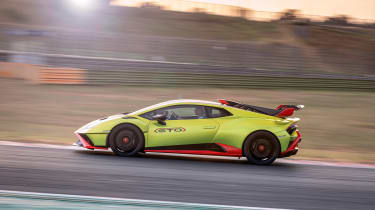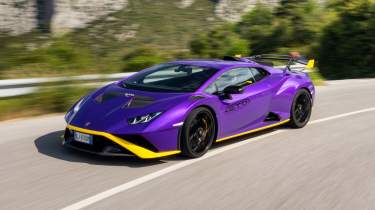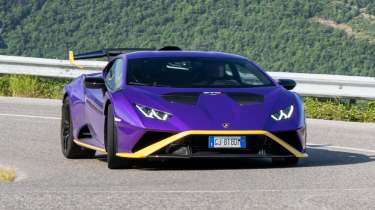Lamborghini Huracán STO (2021 - 2023) review – the ultimate hardcore Huracán
Lamborghini’s V10 went out with a bang with the ultimate Huracán racer for the road
The Lamborghini Huracán STO is the ultimate hardcore expression of what a road-legal Huracán can be, draping almost race-spec aerodynamics inspired by the Super Trofeo race car over the Evo powertrain with the front driveshafts removed. It’s about as close as the Huracán ever got to full ‘GT3 RS’ spec and was a direct opponent to Ferrari’s Pista and McLaren’s LT lines of hardcore supercars.
So delicious was the STO’s package, that it had to make the last minute dash to come along to our 2021 evo Car of the Year. In fact, it battled it out right at the top of that year’s field, all while giving both driver and bystander the full experience of its most spectacular powertrain. We subsequently had the STO back for a battle of four hardcore naturally aspirated specials and back to Anglesey for a test against the stopwatch. Every time we got behind the wheel, the STO blew us away.
Engine gearbox and technical highlights
- 57 per cent more downforce than the Performante
- 43kg lighter than the Performante
- ‘Cofango’ unified clamshell nose is hugely theatrical
Of course, the STO retains the glorious naturally aspirated 5.2-litre V10 that powers only the rear wheels and focuses much more on balance, agility and lap times than raw power figures. In fact, the V10 is untouched and produces an unfashionably ‘ordinary’ 631bhp at 8000rpm and 417lb ft at 6500rpm – minnow figures in a world of 800bhp Ferrari 296 GTBs and 750bhp McLarens. It was enough to get it to 193mph and from 0-62mph in 3-seconds dead but with the discontinuation of the Huracán comes the ultimate overcompensation to replace it, the 907bhp hybrid Temerario.
More reviews
There’s so much detail work in the STO. Weight was chased out wherever possible, creating some really cool features. As well as the usual tricks of thinner glass, optional magnesium wheels and extensive use of carbon fibre panels (everything but the roof and door skins is composite), Lamborghini adopted a single piece for the wings, bonnet and front bumper called the ‘cofango’ that calls to mind the front clamshell of a Miura.
Functional and evocative, which is sort of the whole philosophy behind the STO. The result is a dry weight of 1339kg… some 43kg lighter than the Performante. Not bad, but some way off a 765LT and you might expect a bigger weight saving considering it’s lost the four-wheel drive system, too.
Of course the Temerario might take visual inspiration from superbikes with its exposed rear wheels and hatcheted surfacing but it trails the Huracán STO for visual drama and purpose. Gone was the unique ALA system that tried to help turn the Performante by varying the aero load across the width of the car and in its place is a more conventional but more powerful system.
The STO’s huge rear wing can be manually adjusted between low downforce (324kg at 174mph), mid (363kg) and high (420kg). The cofango – complete with louvres to exit hot air from the wheel wells and bonnet vents to extract hot air from the radiators – is also a powerful tool in the aero set-up, and the shark fin on the rear deck is said to improve yaw stability. Overall aero efficiency is improved by 37 per cent, with downforce 53 per cent up on the Performante.
The STO also adopted the latest CCM-R brakes from Brembo and a bespoke Bridgestone Potenza tyre in Sport or Race configurations. The latter is the equivalent of a Michelin Pilot Sport Cup 2R and whilst isn’t quite as quick over a single lap is said to have more stable characteristics and greater longevity. Three new driving modes were added on the ANIMA system – STO for road driving, Trofeo for the track and Pioggia for rain.
These act on dampers, traction control and ABS settings, exhaust sound, torque-vectoring and the rear-wheel steering system. Lamborghini also removed the Dynamic Steering system, so the steering ratio is always the same at 13.4:1. Praise be to all that’s good and holy. Finally there was the Squadra Corsa options package to consider, which added magnesium wheels, a titanium half-cage and harness bar and an onboard telemetry and camera system.
Driving the Huracán STO
‘After two hours of near-continuous lapping at Vallelunga we’re confident enough to say that the STO is pretty special on track. Some things are very predictable: The engine and 7-speed DCT ‘box remain absolutely sublime.
'An ‘F8 might hit harder, a 765LT might feel even more manic at the top end, but for response, noise and giving you instant, millimetre-perfect access to the chassis no other supercar in this sector comes close. It is jaw-droppingly fierce, possessed of wonderful accuracy (Lamborghini introduced a much more linear throttle map for all ANIMA settings so the somewhat binary response of the old Corsa mode was eradicated) and it creates a noise to make you weep for joy.
‘Less predictable is the wonderfully fluid, adjustable feel that characterises the car. I’d expected lots of grip and stability but a slightly more prescriptive experience. Lamborghinis often lack the delicacy of rivals, yet the STO blows that preconception out of the water. It feels light, agile and really responsive to anything the driver asks of it. The mildly tail-led high speed balance is simply gorgeous and the car feels at once playful and completely on your side. The old cliché that Huracán's doggedly understeer can be laid to rest.
‘The Bridgestone tyres and brakes deserve a special mention. Their performance is astonishingly consistent even with a track temperature hovering around 60-degrees Celsius and a series of rapid-fire sessions of four or five fast laps. The lap time drop-off was negligible all day and the brake feel – once an Achilles heel of Lamborghinis – is very good indeed. For me, the steering lacks the absolute clarity of, say, a Porsche 911 GT3.
‘On-road, the experience doesn’t falter as overtly track-focused specials so often do. That wonderful, approachable balance is just as acute. Of even greater surprise is the suspension, which seems to be able to find equilibrium with the road surface that belies its impregnable body control. Over rough roads, the steering remains uncorrupted and doesn’t jitter around in your hands as the weighting on track might suggest. The brakes meanwhile are just immense on road, and every one of its 631bhp feels like it’s being translated onto the road with almost supernatural levels of traction.
‘True, we’d like more variability in the driver modes, and it’s hardly a relaxing experience to endure the bucket seats and road noise over longer journeys, but we can think of few contemporary supercars that fly so high.’ – Jethro Bovingdon.
evo Car of the Year 2021 verdict
‘‘In the dry and as long as the road isn’t truly appalling, the STO is just the absolute king.’ We knew Jethro was a fan of the Huracán STO before eCoty, and after a few more days with it his enthusiasm only grew stronger. ‘The front end is nailed to the road and so responsive,’ he added.
Steve declared it ‘in many ways the car of 2021. It’s the one everyone said they would pour their last gallon of petrol into. It’s basically just a straightforward supercar with a big atmospheric V10 in its guts, connected to a great gearbox, which sits in the middle of a beautifully balanced rear- wheel-drive chassis.’
When you put it like that, it’s hard to argue against, and everyone stepped out of the STO with a grin and a tale to tell. Its engine is all-encompassing, the shifts of the dual-clutch ’box so precise, and you can enjoy it on almost every road. ‘The way it steers and turns into a corner, and then seems to build lateral force as though there’s a clichéd slot-car rail carved into the tarmac’ is what did it for Adam.
Henry was one of the three who had it first on his list (along with Dickie and me), loving the feeling of lightness, the stripped-back interior and even how it looked from the outside. It was a drive shortly before he had to cast his votes that crystallised the car for him: ‘On a piece of tarmac that exposed flaws in the 911, the STO felt trustworthy.
You always felt in control. Once you’re in tune with the car it feels more positive and engaging than last year’s Huracán EVO RWD.” Not everyone was such a fan, although the lowest it finished on any individual’s score sheet was third, and John (who placed it second) felt that the Evo RWD would still be hard to beat for him, saying of the STO: ‘Unless you want more attention I can’t see the £100k gain.’ And still not being able to personalise the driver modes by separating the engine, gearbox and damper settings is a shortcoming in what is the very best Lamborghini of the 21st century.
But as Dickie explained, the STO perfectly highlights the appeal of a raucous, simple, naturally aspirated supercar, feeling exciting all of the time. ‘I had by far the most memorable drive in this car, which is usually the most reliable benchmark on eCoty. It’s the last of its kind at the top of its game.’ What a car.’ – Stuart Gallagher, evo editor-in-chief.
On track
‘The sharp, on-the-nose balance seems perfectly suited to a car that is ferocious in every sense. And, my god, that V10 is almost overwhelmingly exciting. Response is instant, the noise pure and brutally loud, and yet the delivery is wonderfully precise. The engine’s character is mirrored in the whole experience. The STO can feel shockingly violent on the one hand, but the quality and accuracy just below the befuddling sensory overload provides absolute control. Intimidation becomes confidence almost like a light switch.
'Despite competition-car looks and Bridgestone tyres marked ‘Race’ the STO is not one of those cars that has mechanical grip to blow your mind. The Bridgestones don’t look as extreme as the benchmark Cup 2, let alone the near-slick 2 R, but they’re a crucial part of the STO’s expertly judged balance between power and grip.
‘The data reveals that the STO’s corner speeds are almost identical to those of the 911 GT3 Touring running P Zero Corsa tyres. We know the 992 GT3 has very good grip and stability so that’s a strong result. Better still, in the middle of the corner you have an extra 128bhp to play with and a chassis that allows stunning accuracy once the rear tyres are over-speeding. It’s an absolute riot.’ – John Barker, evo editor-at-large.
| Car | Angleysey evo leaderboard lap time |
|---|---|
| Ferrari 488 Pista | 1:10.8 |
| McLaren 765LT | 1:11.1 |
| Lamborghini Huracán STO | 1:12.7 |
STO v mid-engined screamers
‘The steering is too light in STO mode, so you must ramp everything up to Trofeo. Even with the added weight, the front end is so positive it takes a while to slow your hands. The brakes are inconsistent. Sometimes they grab the Huracán hard enough to stand it on its nose even when you just want a confidence dab, then the next corner the pedal might be longer than anticipated. It’s annoying but you learn to live with it, for so much of what the STO does is of the highest quality.
‘Incredibly, the chassis doesn’t just play a supporting role here. There’s so much front-end grip and such reassuring balance that it’s almost prodding you to explore the V10 in ways you never have before. The STO loves to carry speed, streaming into corners fast and perfectly in control. You don’t feel the rear-steering’s work but boy do you appreciate the agility. Then you can really get into the power, leaning on the front-outside wheel and carving clean lines.
‘Understeer? The STO doesn’t do that on the road. Ever. It just feels nailed to the apex, and as the V10 climbs the rev range from mid-corner onwards, simply unwind the steering lock as the rear takes on the slightest yaw angle. Firing onto straights in this deliciously poised state, giving the engine its head and hitting an upshift just as the V10 brushes the limiter is mesmerising. The melding of total control with such raw, untamed performance is about as exciting as it gets.
‘The STO can feel too stiff and intolerant of timid mid-corner lifts at times, plus the weight of the V10 starts to tell at really high speeds, but for the most part it’s just an overwhelming experience. Emerging at the next stop, I can barely believe this much fury is legal. It’s indecent.’ – Jethro Bovingdon.
Price, specs and rivals
Our favourite slide on the STO’s press presentation was simply entitled ‘Celebration of the Combustion Engine’. This hardcore Huracán delivered on that promise but is so much more than just a platform to demonstrate that mighty 5.2-litre V10 – an intense driving experience (if not outright lap pace) that easily stands toe-to-toe with rivals from the likes of Ferrari and McLaren.
It wasn’t cheap at £260,012, before you even think of the Squadra Corsa options package. But then, they’ve not really depreciated, with the very cheapest STO examples on the market for in the region of £260k.
Specs
| Engine | V10, 5204cc |
|---|---|
| Power | 631bhp @ 8000rpm |
| Torque | 417lb ft @ 6500rpm |
| Weight | 1339kg (dry) |
| Power-to-weight | 479bhp/ton (dry) |
| 0-62mph | 3.0sec |
| Top speed | 193mph |














